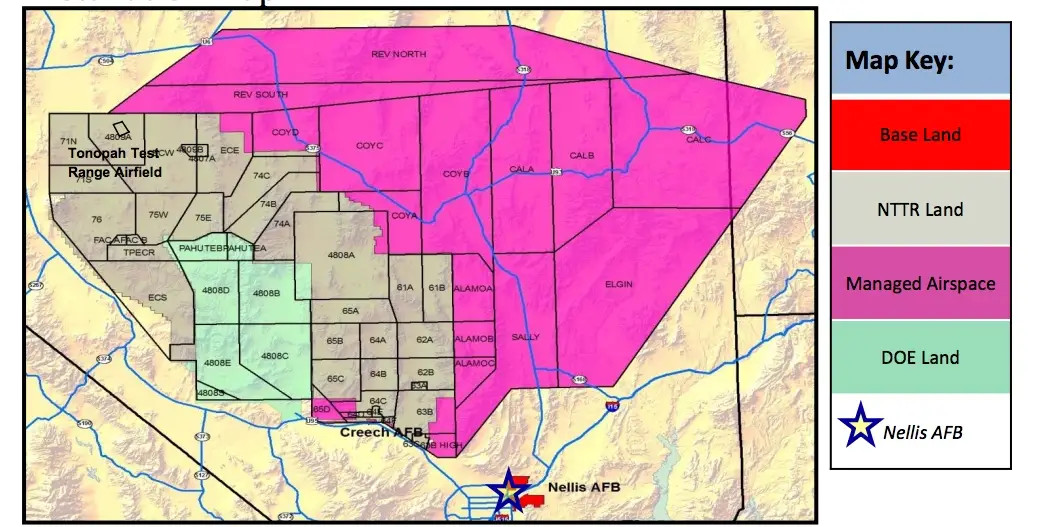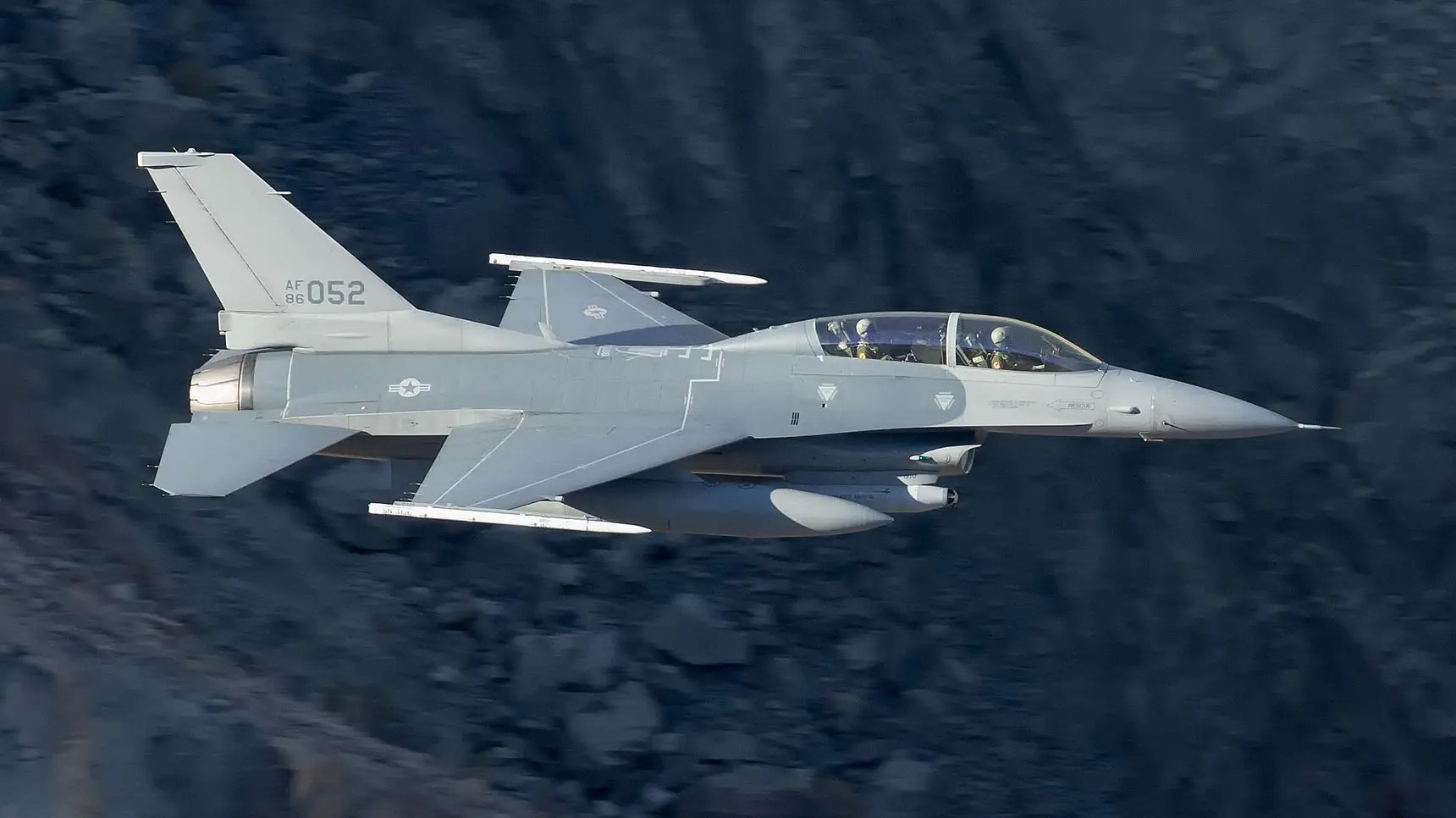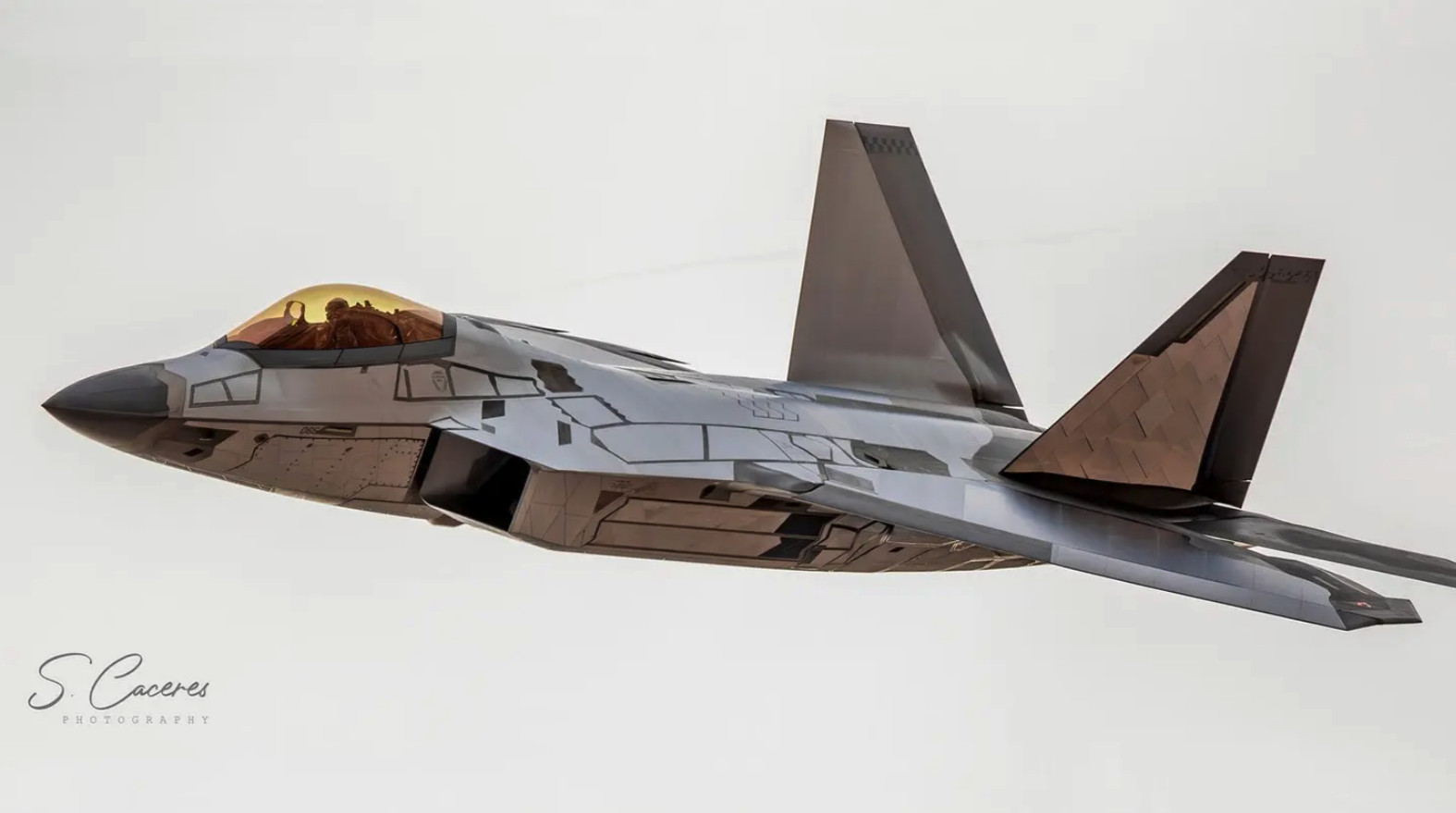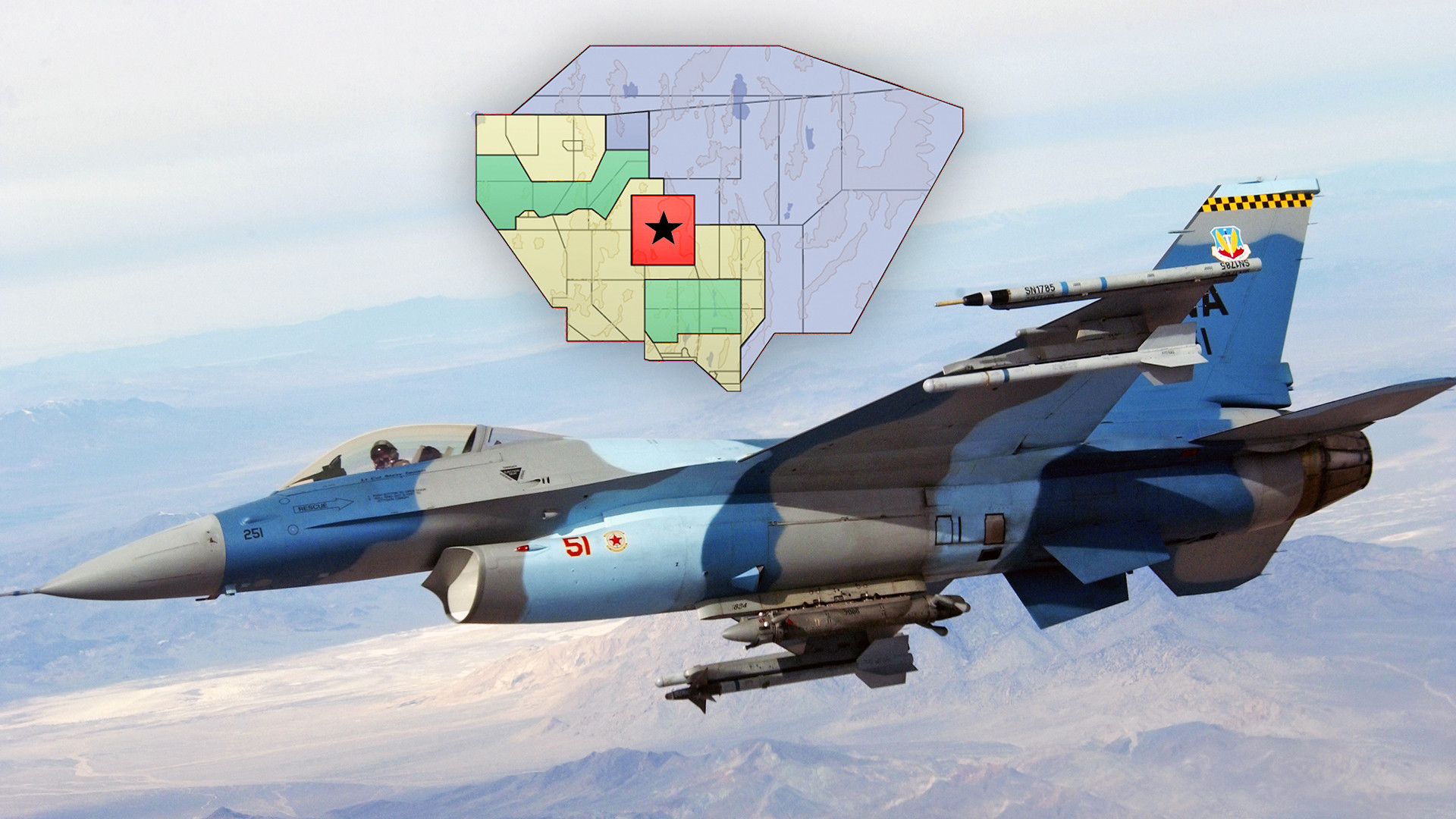The U.S. Air Force’s Red Flag large force employment (LFE) exercises are world-renowned for their scale and scope, and always involve a slew of different types of aircraft flying together. The last Red Flag event of the 2022 Fiscal Year, referred to as Red Flag 22-3, appears to have had some particularly notable participants last week. These came in the form of aircraft operating from the highly-secure Groom Lake test facility, better known as Area 51, using ‘MiG’ callsigns.
Joerg Arnu, an Area 51 researcher and webmaster of Dreamland Resort, a website dedicated to the history and goings-on at Area 51, first posted a collection of audio recordings he had made of radio chatter between these unusual Red Flag participants and air traffic controllers on July 13. This included communications from pilots using the callsigns MiG 5 and MiG 6, as well as MiG 1 and MiG 2. However, only MiG 5 and MiG 6 could be heard specifically while launching and recovering from Groom as part of the larger Red Flag day and evening missions. Arnu subsequently told The War Zone that he has now also overheard a third pilot, using the callsign MiG 7, during flights to and from Area 51.

“In over 20 years of monitoring Area 51 and Red Flag I have never heard aircraft from Area 51 participate in Red Flag. During this Flag’s (22-3) sorties I have repeatedly heard at least three aggressors (callsigns MIG 5, 6 and 7) launch from Area 51 and RTB [returned to base] there after the sortie,” Arnu said. “They checked in with Area 51 Control and later Tower on the unpublished UHF frequencies normally used by test or mission aircraft out of Area 51.”
Red Flag 22-3 is already notable in that it is a relatively rare U.S. military-only iteration of this exercise, which points to the inclusion of particularly sensitive capabilities. Red Flags typically include aircraft and personnel from at least some allied and partner countries, which can preclude the use of any highly classified assets.
The exercise, which is being run out of Nellis AFB in Las Vegas, and conducted in the airspace over the adjacent sprawling Nevada Test and Training Range (NTTR), started on July 9 and is set to wrap up on July 29. Area 51 sits inside a heavily restricted area referred to as “The Box” in the middle of the NTTR.

“It cannot be stressed enough how unusual it is for aircraft from Area 51 to participate in Red Flag,” Arnu said. “Normally the airspace of Area 51 is strictly off limits to Red Flag players and during Red Flag phases mission flights out of Area 51 are scheduled to not conflict with Red Flag sorties.”
The Area 51 airspace is so sensitive that is widely known that even visiting Red Flag aircrew participants will be grounded and/or sent home if they violate ‘The Box’ during Red Flag sorties, also referred to as ‘vuls.’
There are no clear indications one way or another as to what aircraft these ‘MiG’ pilots have actually been flying. However, the Air Force has already said publicly that Red Flag 22-3 features an aggressor force unlike any that has been employed in one of these exercises in the past. The recently activated 65th Aggressor Squadron, equipped with stealthy F-35A Joint Strike Fighters, which is currently focused on mimicking Chinese threats, is a key part of their all-new adversary air equation.

The “dedicated multi-domain aggressor force” from Nellis’ 57th Operations Group, which includes units that provide mock “fighter, space, information operations and [ground-based] air defense” adversaries, is another core component. The 64th Aggressor Squadron, which flies F-16 Vipers and whose pilots often use ‘MiG’ callsigns, is one part of this aggressor contingent, which is sometimes referred to as “Aggressor Nation.”
“The Aggressor Nation will be unleashed as they refine threat replication, apply advanced threats and jamming capabilities, and increase threat capabilities to maximize training in non-permissive environments,” Air Force Col. Jared Hutchinson, commander of the 414th Combat Training Squadron, the unit that manages the Red Flag exercise program, said in a statement earlier this month. “The airspace is also much different with almost twice as much fight airspace and inclusion of neighboring airspace opportunities to optimize Blue and Red Force tactics.”
Being able to launch aggressors from remote airfields, like Area 51, only enhances the overall training experience by recreating the dynamic nature of a wily adversary’s fighter operations. The slightly less secretive Tonopah Test Range (TTR) Airport, also situated within the NTTR, has been utilized for this purpose in the past. Groom Lake, with its more central location within the NTTR, would be even better positioned for this purpose.
With this being a U.S.-only training event, it is even possible that Red Flag 22-3 is being conducted, at least in part, within “The Box.” This would also fit with Col. Hutchinson’s comments about the use of additional airspace for this iteration of the exercise. It’s also in line with what we know already about initiatives within the Air Force to expand the space available for use during various large force exercises, as well as its partnering with other services in this regard, to find ways to better simulate major high-end conflict scenarios that will occur over large geographical areas.
It is, of course, possible that this isn’t the explanation, or the whole explanation, for aggressors flying from Area 51. The callsigns had immediately led some to wonder whether the pilots in question were flying Soviet, Russian, or other foreign aircraft as part of Red Flag 22-3.
Area 51 is understood to host a secretive unit nicknamed the Red Hats that specializes in so-called foreign military exploitation (FME) work – primarily the testing and evaluation of foreign military hardware acquired through various means – and that flies Soviet-designed Su-27 Flankers and MiG-29 Fulcrums, possibly among other non-U.S. types.

For many years, another separate FME unit nicknamed the Red Eagles based at Tonopah flew various Soviet and Chinese types to provide valuable dissimilar air-to-air training support for U.S. and allied pilots. It is understood that the Red Hats assumed the Red Eagles’ mission in the 1990s after the latter unit was officially inactivated, and have continued to offer these services, including to select participants during weeks of Red Flag exercises, but not during the wargames themselves, and for students of the prestigious U.S. Air Force Weapons School.
At the same time, the foreign aircraft based at Groom are notably camera-shy as their very existence within the U.S. military’s inventory is officially undisclosed and they are treated as ‘sight sensitive’ assets. So, their direct participation in Red Flag 22-3 elsewhere within the NTTR seems less likely. The same could be said about the possibility that these ‘MiGs’ were actually some other kind of prototype advanced U.S. military aircraft. While unlikely to be the case, flying directly out of Groom would make sense.
Another possibility is that the pilots in question were flying some of the two-seat F-16D Viper fighter jets based at Area 51 to support the work that goes on there. One of these aircraft was spotted back in 2017 flying through Rainbow Canyon, also called “Star Wars Canyon,” in neighboring California. The pilot and back-seater in that Viper were wearing Red Hats and Red Eagles patches and the aircraft was notably carrying a version of the Lockheed Martin Legion Pod fitted with an infrared search and track (IRST) sensor.

IRST systems have been around for years and are currently making a major comeback within the U.S. military, including with the Air Force, which is now actively fielding Legion Pods on F-15C Eagles. These sensors offer fighter pilots, in particular, an additional valuable tool beyond radars to detect and track threats, including stealthy platforms, and do so in a passive manner that doesn’t alert opponents as to the host aircraft’s presence, as you can read more about here.
Various Russian-made jets, including variants of the Su-27 and MiG-29, feature integrated IRST systems, which could be part of the reason why the “MiG” callsigns were chosen. Red Hat pilots, as a product of their work, are connected to the aggressor community at their core and are well versed in Russian and other foreign tactics, techniques, and procedures, making them very realistic adversaries to train against. F-16Ds equipped with Legion Pods and other systems capable of mimicking foreign sensors or other capabilities, and with Red Hat pilots in their cockpits, would have be valuable additions to the “red air” force supporting Red Flag 22-3.
The Dreamland Resort’s Arnu raised another possibility to The War Zone. “The two chromed F-22 observed in RF 22-1 that were testing new stealth coatings come to mind. Perhaps that research has entered a phase where the modifications must be kept from curious eyes,” he said. You can read more about the F-22 Raptor stealth fighters in question, one of which is seen in the picture below and that have a metallic-like coating that appears to be designed to further reduce their signatures, particularly in the infrared spectrum, here. The Air Force also disclosed earlier in the year that F-22ss are being used to test various components being developed under the service’s Next Generation Air Dominance Program (NGAD), some of which may ultimately be integrated onto operational Raptors.

At least one of the Air Force’s remaining fleet of flyable F-117 Nighthawk stealth combat jets has been seen with a similar metallic-like coating. The last F-117s were officially retired in 2008, but a number of them have been conducting various research and development, test and evaluation, and training tasks since then, including acting as stealthy aggressors in support of large exercises like Red Flag. They could be flying from Area 51 as part of Red Flag 22-3, but there would be little reason to do so outside of using the base to simulate a forward airfield, just like an aggressor F-16 could.
No matter what, by every indication, the all-U.S. Red Flag 22-3 appears to be a particularly significant iteration of the Air Force’s premier air warfare exercise.
Contact the author: joe@thedrive.com
